Very rare 1979 Dodge 300S now in safe hands
Posted by Chris Graham on 7th November 2023
Pip Dunn tracks down a rare 1979 Dodge 300S that, even when new, was something of an oddity, and meets owner Mark Thomas to find out more.

When Mark bought this 1979 Dodge 300S there were just under 226,000km on its odometer. That’s actually an incredibly low total for what was then a 40-year-old lorry!
Every time I go to a classic commercial show, there’s always something that catches my eye and I think: ‘I must go and see that and find out more.’ Well, that was most definitely the case when I spied Mark Thomas’ Dodge 300 at the covid-delayed Gaydon show in August 2021.
As the world – slowly – got back to normal after the pandemic we could, at last, start getting out and enjoying everything we had taken for granted before the world was shut down. At that show, I first met Mark and his – then jet black – Dodge 300 MUY 502T, and it immediately excited me in the way only an old lorry can!
Given my age, I can just about remember Dodge 300s on the road. That said, they were never especially common in the UK, as they didn’t sell as well as Volvo F86s (and then F7s) or ERFs and Fodens. They were something of an oddity. But equally, they were not drop dead rare like, say, a Saurer or a Dennison…

The Dodge was new to a Black Country chain manufacturing company.
The Dodge 300 was actually a Spanish-designed lorry built by Barrieros. That company was acquired by Chrysler in 1969, which had acquired the UK Dodge operation. So when Dodge was looking to introduce a more modern – and heavier – lorry to the UK market in the 1970s to run at 32 tons, the Barrieros cab designed in 1972 was the obvious fit. It was an interesting cab, sort of stylish, but equally sort of ugly, and the fact it tapered in towards the roof meant it didn’t necessarily make the best use of the envelope available to it, certainly for the driver. It did, however mean it was potentially more aerodynamic.
Either way, it was sold in the UK as a day and sleeper cabbed tractor unit and also as a day cabbed 6×4 and 8×4 tipper. But it was in a very congested market with competition from home and abroad. In the 1970s, there was Leyland, Seddon Atkinson, Foden, ERF, Ford, and Bedford not to mention DAF, Saviem, Berliet, Scania, Mercedes, Magirus Deutz, Fiat, Volvo, MAN and even Mack all trying to sell their wares in the UK. There was only a small slice of the market share pie that Dodge was ever going to secure.
Tilt cab
The model number for Mark’s Dodge is the R3820-P, a later derivative of the original K3820 by virtue of it having a tilt cab and a Fuller gearbox. The 4×2 tractor unit has, in theory at least, a sleeper cab, which, when it was registered on March 1st, 1979, was still not a given for many drivers in that day and age.

Collection from the Welsh borders.
It was new to Parsons Chain manufacturing of Stourport who used it for about four years and put a paltry 185,000km on the clock. And those were its most intensively used years!
It was then sold to Tom Henderson who acquired it purely to move his traction engine Pride of the Wye to and from shows. Ad hoc work of limited mileage, meant over its 36 years with Tom saw it only accumulate about and extra 40,000km. In fact, when Mark got it, there were just under 226,000km on its odometer. That is an incredibly low mileage for what was now a 40-year-old lorry!
So, while the Dodge had enjoyed a pretty relaxed life, by 1990 it was quite old and had suffered from some patches of rust which led to Tom replacing a few of the cab’s panels to improve its longevity.
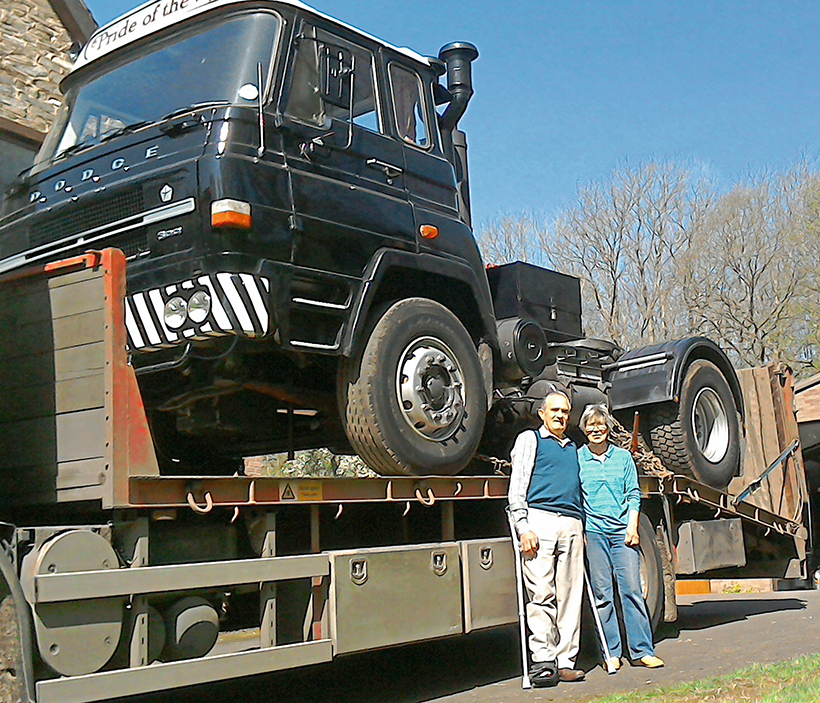
Second owner used the Dodge for moving his steam engine, and stopped driving it at the age of 80…
Mark bought the unit in April 2019 and collected it from the Welsh borders to bring back to his house in Burnham, near Slough where he would complete its return to use. Having been ‘under used’ over those 40 years it didn’t need a full restoration or even a light overhaul. Sure, it was dated, but everything was on it, and it was a runner.
Says Mark: “the lorry now is pretty much in the same condition as it was when I bought it, other than its colour. I’ve not had to do any major mechanical work on it.”
Mark had to buy it with the trailer that Tom had also used to move his machinery. “It was an all or nothing sale, so I bought it with a single-axle four in-line low loader. I had no use for the trailer, nor the space, so I sold it.”
Mark paid £9000 for the pair but recouped £2,000 from selling the trailer, and he was more than happy with selling out ‘just’ £7,000 to secure the Dodge 300. In fact, considering its condition, and the fact it was pretty much ready to run, and given its rarity, he thinks that was something of a steal. And I have to agree.
Tom was selling the lorry purely because he wanted to take it easy in life – he was 80 when he was finally persuaded by his son that perhaps he ought to consider selling up.
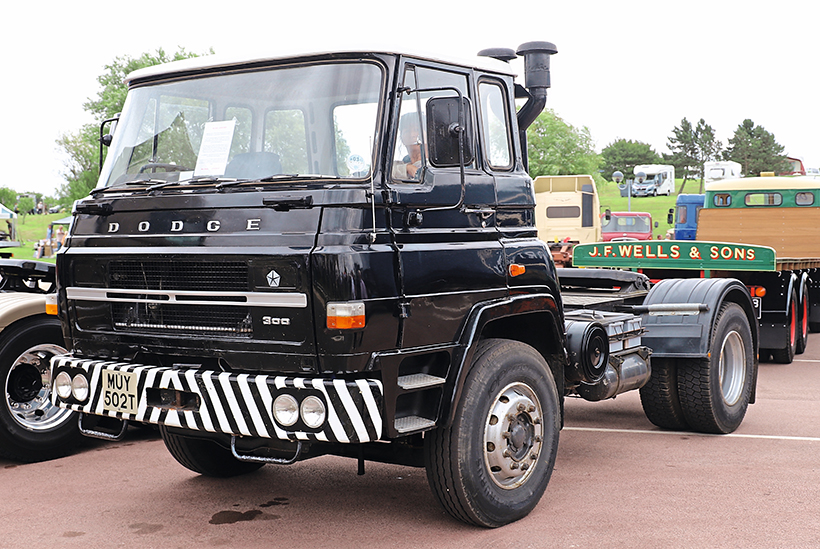
A clean-up and service later, it’s seen here at the 2021 Classic & Vintage Commercials Show at Gaydon.
New home
The Dodge is kept at Mark’s home on the drive, but has a cover to protect it from the elements. He’s insured it for just 1500 miles use a year, and when he takes it to shows, he does so by loading it on the back of another lorry.
Luckily Mark’s job as yard foreman for a local Skip Hire and Plant Hire in nearby High Wycombe means he has access to a Scania beavertail flatbed, which can comfortably take the six-ton tractor unit on its load-bed.
His first show was Gaydon in 2021, when MUY 502T was still painted in its plain all over black of its previous owner. When I saw it for the second time, in June 2023 at Gaydon, the unit had benefitted from a new red and while livery inspired by the promotional Dodge brochures of the 1980s.
“Since I’ve had it, the spend has been pretty minimal. I’ve had a new compressor, and it’s now got a new MAN air-dryer to stop oil coming in from the compressor. I did lose a year trying to get that sorted!”
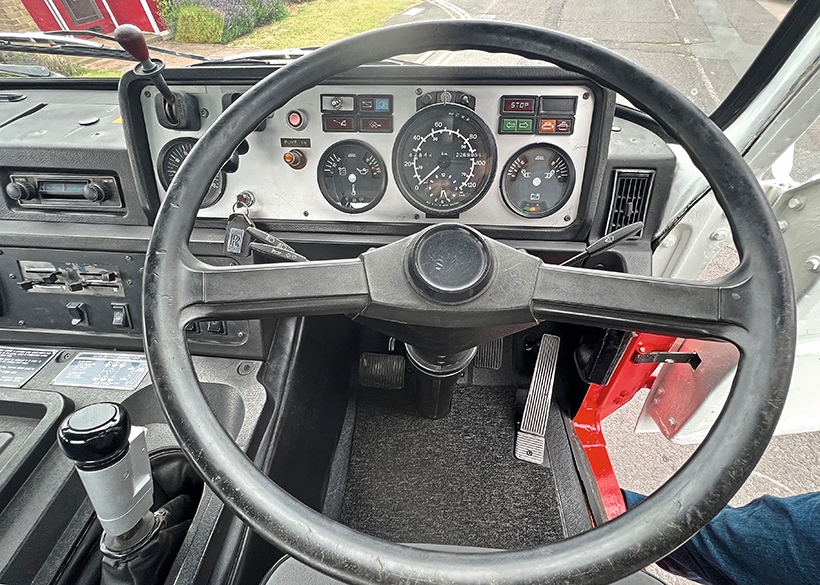
Classic late-1970s dash including the by-now standard analogue Tachograph.
He has also spent a few quid getting it repainted but everything else on the lorry was either original or the work was done by Mark. “I took some bits off it, overhauled them, and then refitted them.”
Being such a rare tractor unit – we think there are three, possibly five, examples still left in the UK – spares are not always easy to come by. “I have to scour the net, that’s for sure!” laughs Mark. “The headlights were round, but I wanted the original square style. I found out by measuring them that they were the same as a Talbot Solara [car] and I sourced some from Spain. They were 24V and exactly the right size and so it now has the right lights in the proper style.”
He’s also had much of the lorry retrimmed with new cloth for the inner roof, insides of the doors and seats all dealt with, while the bunk is still the original trim and, aside from a decent wash, is still in remarkably good condition, although it’s hardly ever been slept on. The re-trim is in the same authentic ‘as built’ style, although Mark laughs that he has no intention of ever sleeping in the cab!
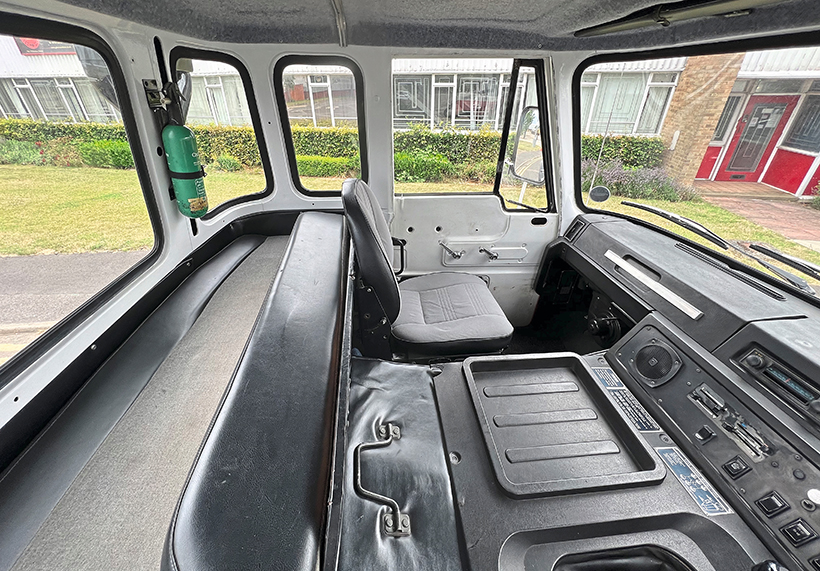
Cab interior. It’s a sleeper cab in theory, but a bit of a squeeze for most – to put it mildly!
In true 1970s style, the cab is fully glazed, with side, quarter and rear windows on the sleeping area – which even with curtains would let a lot of light in, and, without a night heater, a lot of the scarce heat out, so making it a pretty uncomfortable place to bed down. And that is before you take into account the scant size of the bunk which is thin and, well, generally uncomfortable.
Today’s drivers would run a mile if they were expected to sleep in this. Oh, and not to mention you need to be a supple contortionist to physically get into the bunk. And storage? Well, there isn’t really any! You’d have to dump your overnight bag(s) on the bunk while driving and move them onto the seats when sleeping!
But while this cab might seem archaic, cramped, unappealing and basic by today’s standards, back in the late 1970s, when sleeper cabs were still in the minority, it must have seemed a veritable palace compared with the equivalent day cabs of the era!
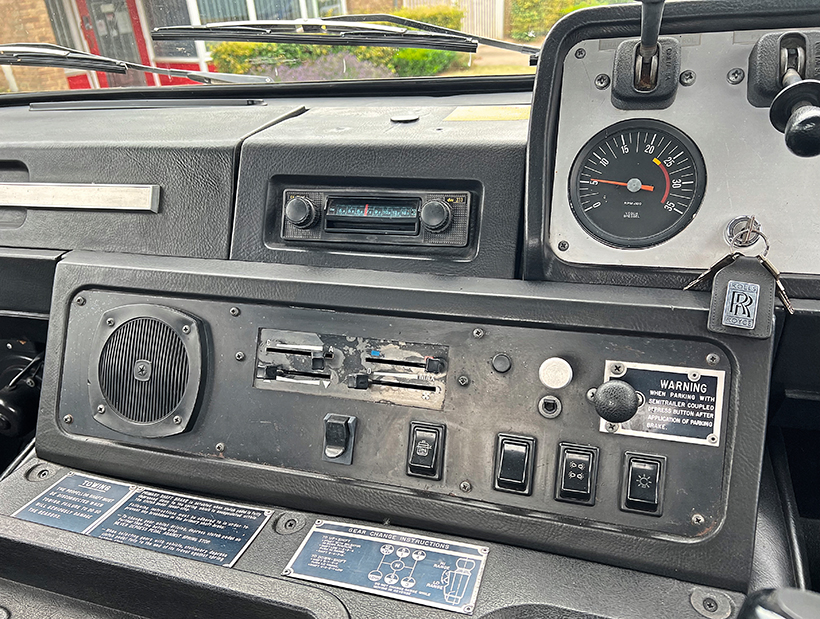
Dash and cab interior generally is in good, original condition, reflecting this lorry’s light-use working life.
Spain remains Mark’s best place to source spares as the Barrieros models were sold in great numbers there, and also beyond 1982 when the 300 Series sales were ended in the UK, plus the warmer climate has limited their scope for rusting away. However, Covid put paid to many of his planned trips to the country to stock up on bits, and more recently there has been a blitz on closing scrapyards in the country.
But Mark is not put off: “I still plan to go over to Spain and trawl the scrapyards for bits. There were lots of sites of the like of Rush Green but many of them are being closed on environmental grounds. So I will have to go pretty soon to see what I can pick up.
“I probably wouldn’t look to buy a ‘whole’ lorry and bring it back as I don’t have the space to store it, plus the transport costs would be high. But I will continue to look for more spare parts [in Spain] that could prove useful in the future.”
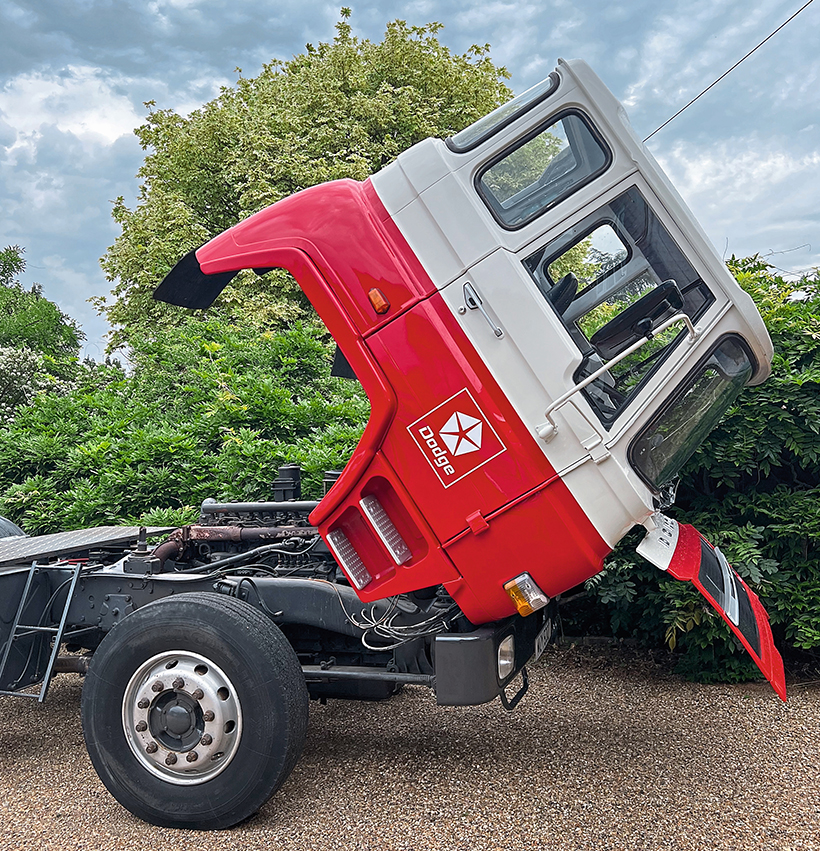
The tilt cab in operation.
The 12-litre lump
Under the cab is a turbocharged 11.94-litre straight six rated at 270bhp at 2,200rpm, which was quite impressive a power output for the late 1970s. The torque rating was 1053Nm at 1,400rpm, also a good level for the time. Also, despite the 300 Series being a 38 tonne tractor design, it was only sold when the weight limit was still 32½ tonnes; by the time the weight limit rose to 38 tonnes, the model had ceased being sold in the UK.
The gearbox was the Fuller RTO 9509/A nine-speed gearbox. Mark’s 300 has the factory-fitted sleeper cab, but day cabs were also available, and probably sold more than the sleeper.
The wheelbase was short – just 2,875mm. the front axle is rated at 7,500kg and the rear axle was 13,000kg, popular in Spain and France, but typically downrated to 11,000kg for the UK. The single speed rear axle ratio was a lively 5.48:1. Other 300s, the C2464 6×4 and the C3084 had the smaller 9.35-litre Chrysler BS16 engine, also a straight six with a turbo, and offering 209hp at 2,200rpm and 850Nm at 14,400rpm.
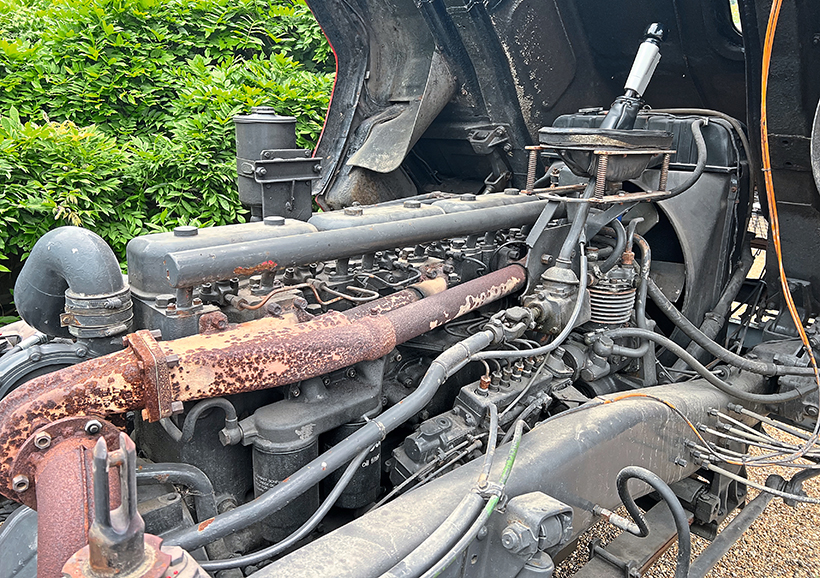
Power unit revealed! Having covered under 227,000 kilometres from new, this is still 100% original, other than routine service-related repairs.
Mark is no stranger to owning classic lorries, he also has a Volvo F86, in store in Carnforth being overhauled and having its chassis resprayed, while in 2015 he bought a Spanish Volvo F89m, which after a two year ‘battle’, he finally got registered in the UK. Both are 4×2 tractor units.
“I started with the F89, it took me three years to track it down. I wanted an F89 [as opposed to a more common F88] as I worked on them as a mechanic for Cavewood from 1986 to 2017. I wanted an F86 as a friend of mine drove one in 1974. It cost just £3000 to get that although the refurbishment is costing me £11,000.” I can’t help thinking though, that that will be money well spent.
Mark says he was never looking for a Dodge 300 “in a million years!” He adds: “I saw it in Classic Truck Magazine when I was looking for bits [for my Volvos]. I didn’t especially want it, but I ended up going over to look at it with a friend. When I saw it, I knew it was just too good to turn down at that price. It was the right price and so rare. It stands out at shows. I knew there were only about two or three more left in the UK, if that. It’s a real head turner and conversation starter.”
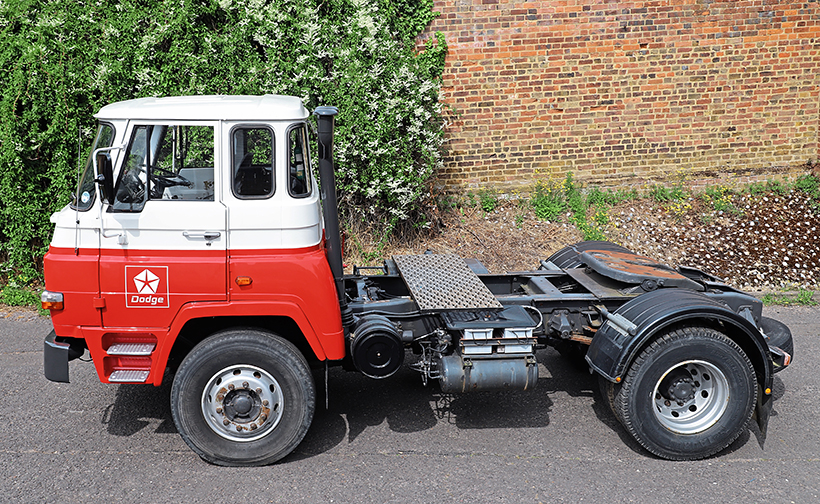
Side view, showing the Dodge 300’s ‘promo’ livery and branding to good effect.
Supportive wife
He has the full support of his wife Lisa, who knows more than a thing to two about lorries and road haulage having spent her life in the industry, including holding positions with Scania, MAN and Renault so she is no stranger the quirky passion that owning old classic commercial vehicles can have on a man!
She has her Class 1 licence, although has so far resisted the temptation to take the Dodge out on the public highways! “She is very supportive of my hobby,” Mark says.
On the road
We can’t resist the chance to take the Dodge out for a spin, not least of all to get some pictures and so we head into the local town centre where there is an old telephone exchange which Mark knows has a 1970s feel about it.
It’s a bit run down, albeit still in use by BT – I’m not sure for what role – but there is one redeeming feature about it…. It most definitely does look so 1970s! It’s the perfect backdrop, especially on one side where the old Telephone Exchange signage is still intact and looks like something out of a Carry On film of the era (and a lot of Carry On outside scenes were filmed around Slough. Ed). So it’s ideal to park a lorry designed in the early 1970s.
A few snaps later, and without getting our collar felt for ‘trespassing’ (in our defence, there was no one around to ask anyway, and what harm were we doing?!) we head off into Slough to a local industrial estate, which too has some pretty old and dated buildings to park it by for more pictures.
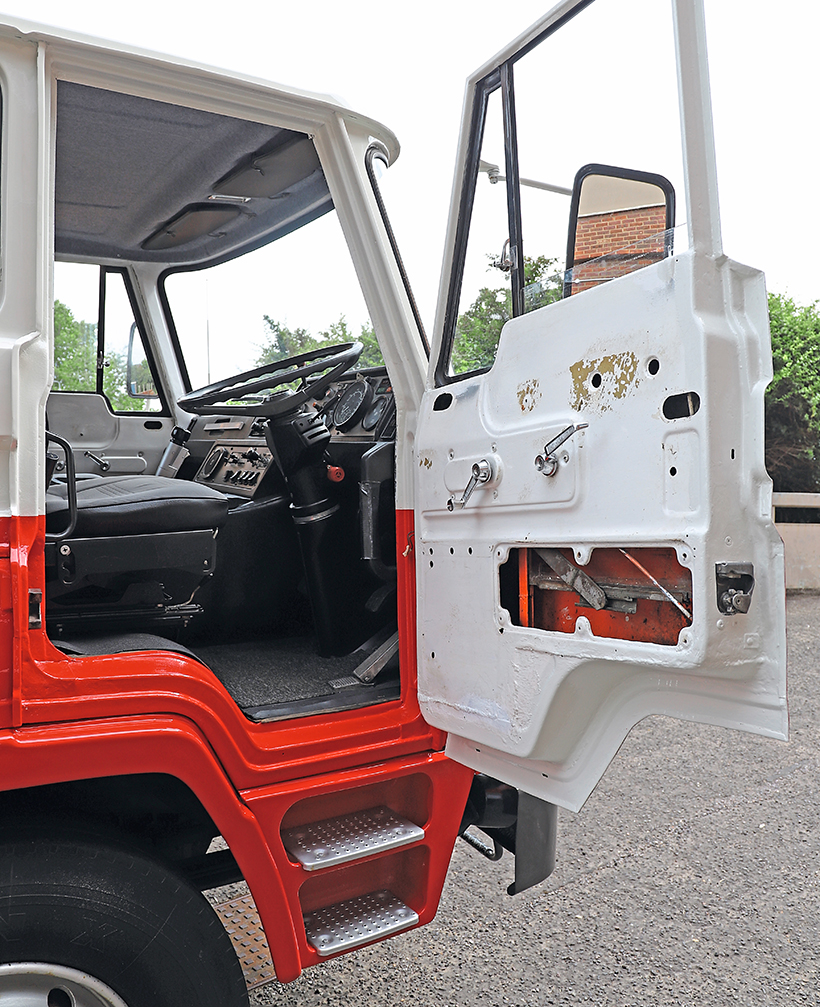
Cab access. Door cards are currently being renovated.
Mark then invites me to have a drive, and having run me though the quirkiness of the gear change – it’s in the reverse pattern on the shift so first is closer to your leg than you might expect – I get the old beast moving.
The clutch is very heavy and changing gear is a challenge for someone like me who rarely drives a traditional gearbox these days, and especially a 44-year-old one.
There’s a few occasions when I get the wrong gear, or failed to get a gear full stop, and ironically the previously quiet industrial estate where we hadn’t see a moving vehicle all morning suddenly – it seems – bursts into life on a Saturday morning, so it’s not long before I’m infuriating other traffic with my ‘erratic’ driving. One person even flicks me the finger and blasts his horn after I’ve inadvertently held him up for, ooh, all of 15 seconds, trying to get the damn gear, obviously taking no account of the vehicle I’m driving and where I’m driving it!
Still, I don’t care. We then see the ‘son of Dodge’ – a Renault Range T and I can’t resist pulling up alongside for a comparison of lorry designs from 1972 and 2013. The driver, clearly not an Englishman, seems perplexed at first, but then actually seems to quite like seeing our smoky, noisy and dated old Dodge rumbling alongside his nice Range T!
A few more pictures later and it’s time to head back to Burnham – with Mark driving again! Back at home, we tilt the cab to show the engine, which, because of its leisurely life, is still all original and in very good shape.
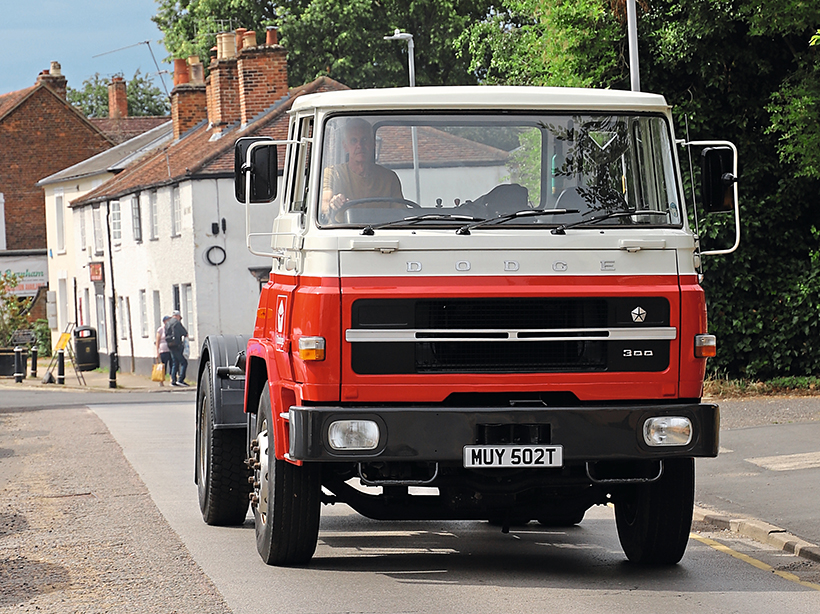
On the move. The author was a lot more impressed by the 300 than he was by driving standards on view around Slough…
That done, a quick coffee as he shows me all the Dodge paraphernalia he’s accumulated over the years since he decided to take a punt on a rather unconventional show piece.
Then it’s off to the next job, and the complete opposite end of the spectrum as we go to Mark’s place of work to see a brand new DAF CF on a 23-plate. And that highlights how much commercial vehicle design has come on in a short pace of time (in fact the first CFs appeared just a decade after the last 300s).
But I have really, really enjoyed my days with the classic lorry, not just because I love all classic lorries, but because it is such a rare beast to boot. Wonderful!
This feature comes from the latest issue of Classic & Vintage Commercials, and you can get a money-saving subscription to this magazine simply by clicking HERE
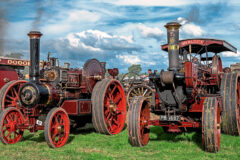
Previous Post
1913 Burrell 6hp No. 3489, George of London spotted

Next Post
1972 Massey Ferguson 625 combine harvester works again



